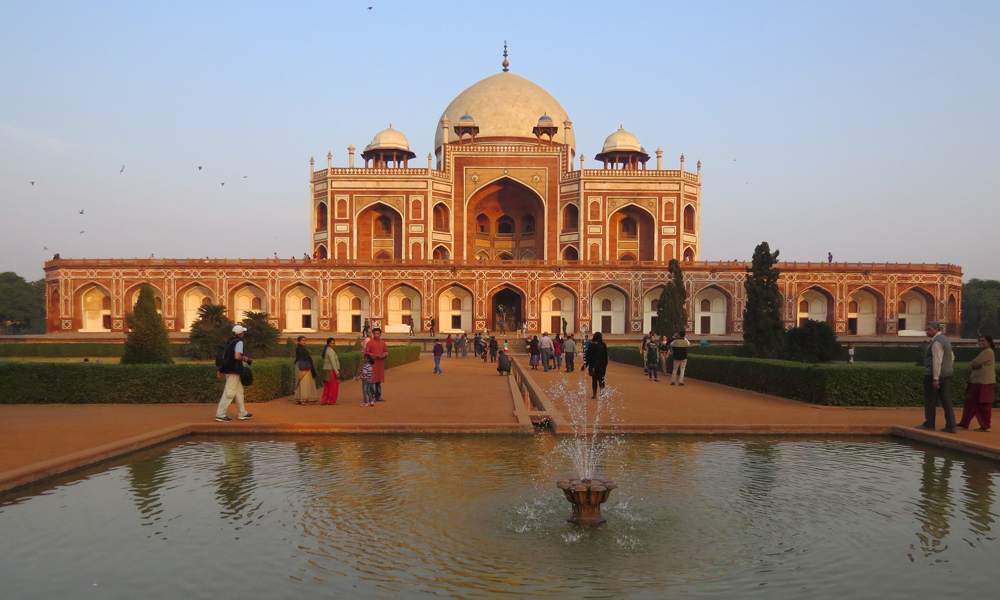
Delhi the capital of India is a very vibrant city and melting pot for all cultures, religions, castes, creeds, and people. This city has withholds a long history in itself. Having seen the rise and fall of many kingdoms, Empires, and dynasties, Delhi today is a perfect fusion of history and the modern world.
Built-in red sandstone during early 13th century, tower of Qutab Minar is one of the tallest tower of its. 72.5 m tall, tapering from 2.75 m in diameter at its peak to 14.32 m at its base, wall consists of the verses from Koran the holy book of Muslims. Complex also hosts mosques and Iron Pillar (Ashoka Pillar) in the courtyard of the mosque, whose quality of the iron is exceptionally pure and has not rusted even after 2000 years.
This 16th century monument is known as the first example of the monumental scale that would characterize subsequent Mughal imperial architecture. Built in the middle of the garden Humayun's Tomb is now one of the best-preserved Mughal monuments in Delhi.
Ultimate symbol of Mughal power is India this 16th century fort was built by emperor Shah Jahan on the bank River Yamuna then. Drum House, hall of Hall of Public Audiences, Hall of Private Audiences, Pearl Mosque, Royal Baths and Palace of Color are some of the main attraction of visit to the palace. An evening sound and light show re-creates events in India's history connected with the fort.
Jama Masjid was the last architectural extravagance of emperor Shah Jahan, which he built shortly after the completion of Red Fort. Highly decorative it is the largest mosque in India its courtyard can accommodate 25000 devotee to offer prayer at one time.
Dedicated to Laxmi (The Goddess of Prosperity) and Narayana (The Preserver) this temple located in the heat of the city is revered by Hindus. Temple complex has numerous small chambers dedicated to various gods and goddesses.
Now a bustling market place was a flamboyant bazzar for the novels, holds a lot of historical importance. Today one can explore Chandni Chowk on a cycle rickshaw to witness reminisce of this market.
Though it is relatively a very new architecture (built in 1986) it has acclaimed many architectural awards and space in international media. Built in white marble this 40 meter tall lotus shaped temple is built as “House of Worship” by the followers of Bhai faith.
Built-in the memory of 70,000 Indian soldiers who lost their life during I World War fighting for British, this arch built on 1921 is a prominent site in Delhi.
President House – Located on the Raisina Hills, Rashtrapati Bhawan as it is popularly called President House was originally conceptualized as House of Viceroy of India in1911 when British empire decided to sift its capital from Calcutta to Delhi. This fortress like 340 rooms palace has been boasts of chandeliers from Belgium, Italian marble, Burmese teakwood, Dholpur stone etc. inside.
Parliament House – designed by Sir Edwin Lutyens and Sir Herbert Baker the man behind the creation of master piece architecture all New Delhi, this 1927 circular building supported by a central dome is hub of world’s largest democracy.
Cremation site of Father of the Nation ‘Mahatma Gandhi’ now boats gardens and a memorial.
Located in the heart of the city Gurudwara Bngla Sahib holds a special place amongst Sikh communities. Eighth Sikh Guru Guru Har Krishan said to have stayed here when it used to be the Haveli or the Bungalow of Raja Jai Singh, an Indian ruler in the seventeenth century. However, he contacted smallpox and took his last breath here. A typical Sikh architecture main building has an impressive Golden doom and complex has a sacred pool (Sarovar), kitchen that feeds thousands of people in a single day, higher secondary school, Baba Baghel Singh Museum, a library and a hospital.
a market complex derived from concept of a village weekly market where art, textiles and culinary/ cuisines from various parts of India is showcased.
A very interesting museum spread over an area of 5 acers of land in the heart of the city, It was set up for preservation of various traditional arts and crafts from various parts of India. Started in 1950s, today it holds over 35,000 exhibits rare and distinctive pieces reflecting the continuing tradition of Indian craftsmen through painting, embroidery, textiles, various crafts of clay, stone and wood etc.
Site by Naulak Web Design.